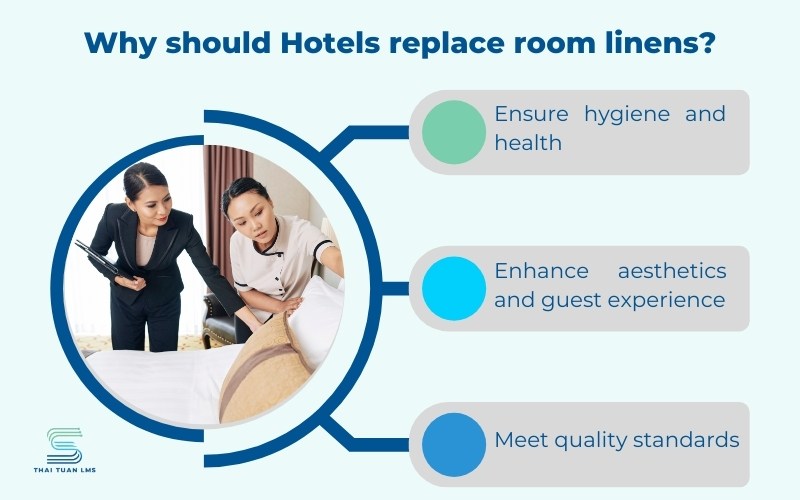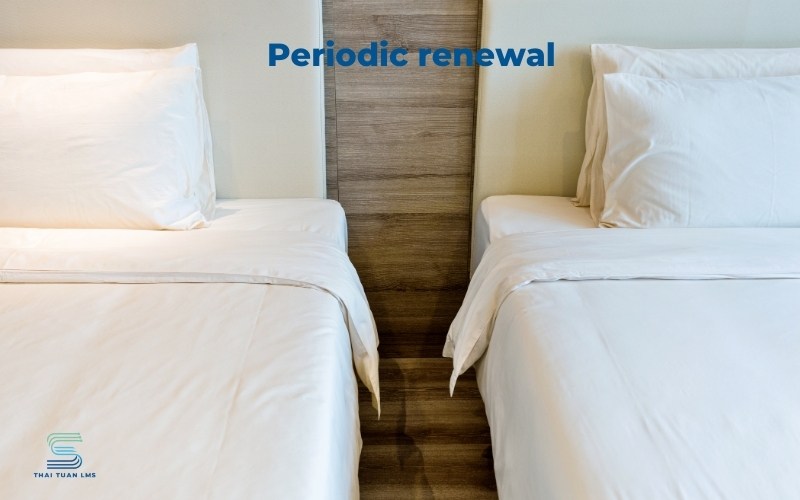Hotel room linens need to be replaced after a period of use to ensure the best experience for guests during their stay. So the question arises, “When should hotel room linens be replaced?” Let’s explore the answer in the article below with Thai Tuan LMS.

Why should Hotels replace room linens?
Replacing hotel room linens is crucial for ensuring service quality and guest satisfaction.
Here are the main reasons why hotels should periodically replace linens.

- Ensure hygiene and health: Over time, linens that have been used and washed numerous times can still harbor various bacteria and mold harmful to health.
- Enhance aesthetics and guest experience: Fresh linens with vibrant colors create a good impression, improve service quality, and enhance the experience of restful sleep and relaxation.
- Meet quality standards: Hotel linens reflect the standards and grade of the hotel itself.
When should hotel room linens be replaced?
Linen shows signs of deterioration
Most fabrics have a lifespan that necessitates replacement. However, certain circumstances may require immediate replacement even before the scheduled time:

- Ripped or frayed: If bed sheets, pillow covers, towels, or washcloths are ripped or excessively frayed, they should be replaced immediately, as this reflects poorly on the service.
- Discolored or faded: If linens have become dull or faded after numerous washes, they should not be used any longer, as they can give the impression of being old and dirty, causing guests to feel insecure about their use.
- Bad odors: If linens such as towels and washcloths retain unpleasant odors even after many washes, they should be replaced.
- Loss of elasticity: Fabrics that have lost their elasticity and are no longer soft like they originally used.
Replace according to a regular schedule
Typically, linens should be replaced after 6 to 12 months of use, with towels, sheets, and pillowcases usually replaced once a year. Blankets and mattresses may last longer depending on usage. The replacement time can vary based on several factors:

- Frequency of use: Linens that are used and washed more frequently need to be replaced sooner than those that are used less often.
- Quality of linens: Higher quality linens generally have a longer lifespan.
- Climate conditions and storage: In humid regions, linens are likely to develop mold and should be replaced more frequently.
Replace or stock up during peak seasons
During peak seasons, the likelihood of full occupancy is almost continuons. To ensure smooth hotel operations, housekeeping staff should check the quality of linens to determine if immediate replacement is necessary or if new ones should be procured as backups for those that are showing signs of deterioration but can still be used a few more times.
Additionally, hotels should prepare enough bedding, sheets, pillows, and mattresses to meet guest demands and anticipate the number of linens needed for replacements when old sheets become dirty, ripped, or if guests request extra beds.
Replacing room linens is a significant investment in enhancing service quality and creating a positive impression on guests. By investing in quality linens and having a reasonable replacement plan, hotels can attract more customers and foster long-term loyalty.

 Vietnamese
Vietnamese  English
English 










